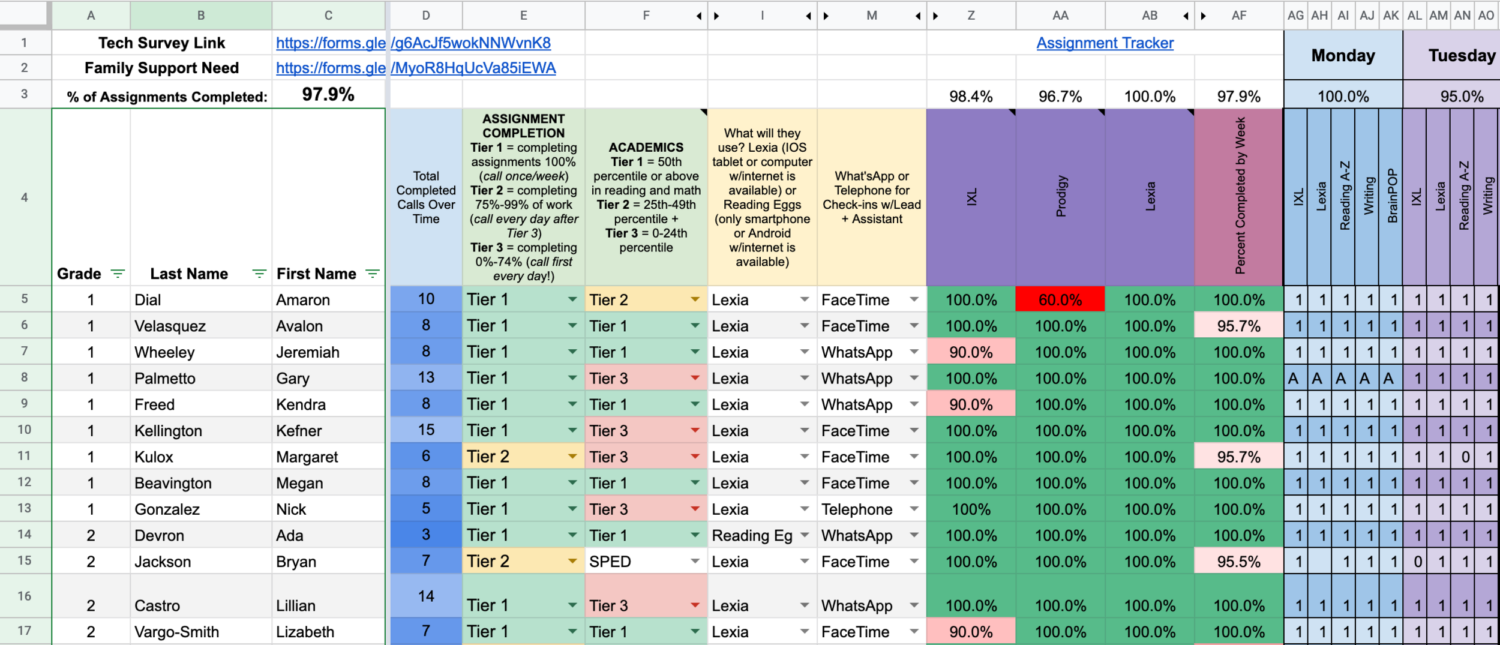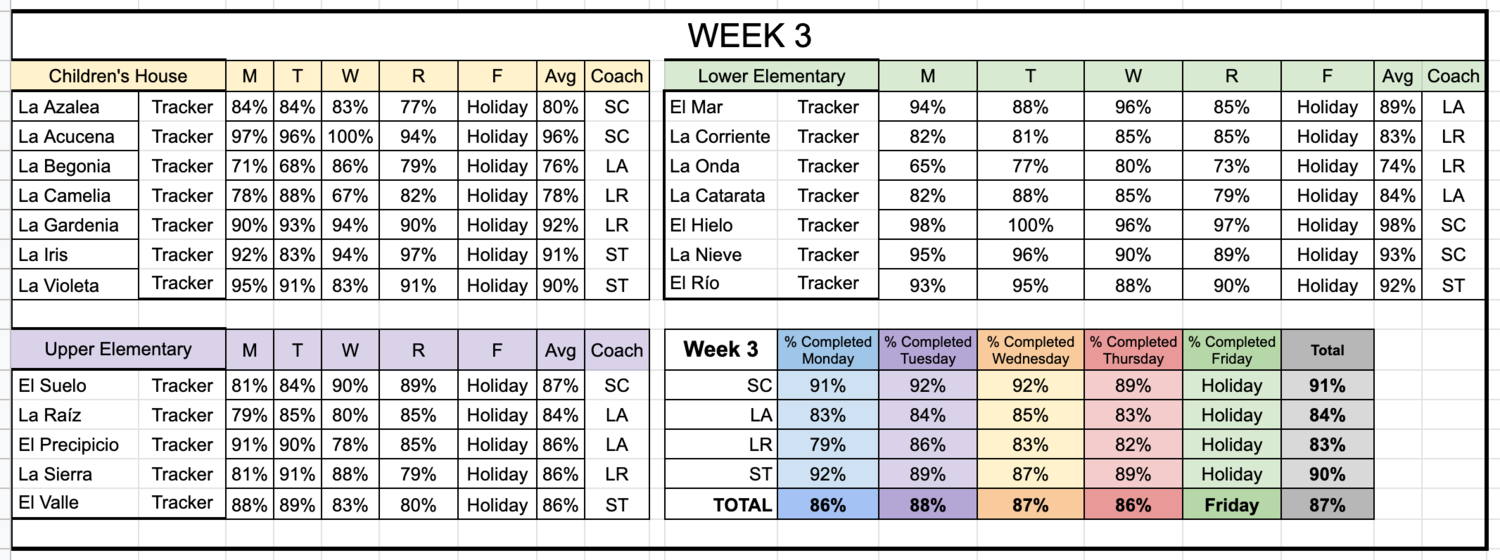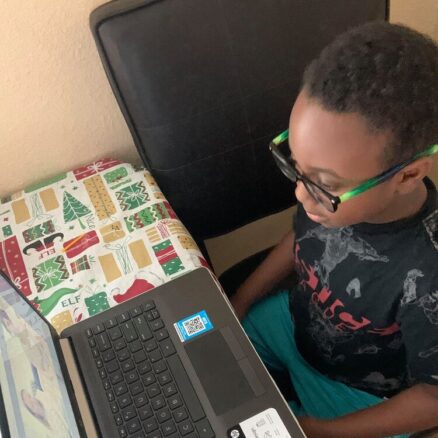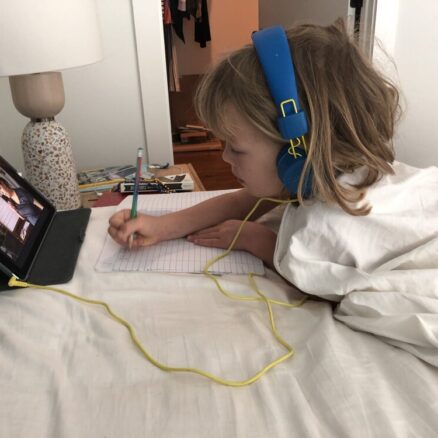Distance Learning for Equity: 10 Takeaways From a Public Montessori Model

Before the Crisis
Magnolia Montessori For All, is a public charter lab school in Austin, Texas, serving 500 children from pre-K through 6th grade. It also includes a non-profit infant and toddler early education center. About half of our families qualify for Free or Reduced Lunch. At our lab school, we are doing R&D to unlock how to fully implement Montessori education in a way that leads to equitable outcomes for all children. Montessori education has been cultivating innovators and leaders for more than 100 years in the United States (including Yo Yo Ma, Beyonce, and the founders of Google) and yet there are 10 times as many private Montessori schools as public ones.
Our intentionally diverse community reflects the belief that schools should be a microcosm of the world and that we should continue to dismantle the segregation that plagues our cities and country.
The Crisis
The COVID-19 crisis is unlike anything that we’ve lived through before, and it is bringing our country’s pervasive inequity problem into sharp relief. As educators, we’re scrambling to adapt quickly and reimagine education. Although we’re all hoping that schools—and our lives—return to ‘normal’ as soon as possible, at Montessori For All we’re paying close attention to the elements of our Distance Learning for Equity approach that can actually support our regular educational model. We know that as we move through this phase of responding to the crisis, we will be gathering the information and insights that will take us into the summer, fall, and beyond. We urge everyone to pay close attention to what you’re learning as you do the unprecedented work you’re undertaking.
Our First Decision
Our Leadership Team built our Distance Learning for Equity model on the assumption that we would likely need to use it for the entire last quarter of school. For that reason, we decided to rely heavily on digital educational apps. We worried about our teachers’ ability to plan for and implement synchronous learning while homeschooling their own children (on top of the fact that families with multiple children would need multiple devices to log in simultaneously). We also felt like worksheet packets would not be sufficiently engaging or provide adequate instruction. We built a suggested daily schedule to show how families could set up a whole-child, Montessori flow to the day at home, while using educational apps for direct instruction and guided practice during the “academic” blocks. This schedule includes space for play, connection with nature, as well as practical life chores that are age-appropriate and help children build their independence and contribute to the family.
Setting Up for Success
We decided early on not to try and do it all at once. We scaffolded and sequenced our plan. We are now heading into Week 5.
- Week 1 Technology & Internet. We connected with 100% of our families to assess their technology and internet needs by the end of Day 1 (reaching the last family at 7:30pm!). We got 99% of families connected to Google Classroom and our educational apps by Day 5.
- Week 2 Google Classroom. We used this week to make sure our teachers were 100% comfortable posting assignments and tracking completion in Google Classroom. By the end of the first week of content, we were up to an 86% work completion rate.
- Week 3 ELA Engagement. In addition to posting assignments and tracking completion, our teachers moved on to tracking actual progress inside our literacy apps: Lexia, Reading Eggs, and ReadWorks.
- Week 4 Math Engagement. In addition to maintaining all of the “spinning plates” of the previous weeks, our teachers added in tracking actual progress inside our math apps: IXL and Prodigy.
In future weeks, we will add in our remaining apps. With a scaffolded plan, we are able to set up our teachers for success while also reserving large amounts of our time and energy to focus on supporting the remaining 10-14% of families that are struggling to engage or sustain engagement.
Top Ten Takeaways from our Distance Learning for Equity
approach that will continue to be relevant when we’re able to return to our physical school campus:
1) Make sure the vision and goals are clear to the whole team. Having clarity during this time has helped our entire team row in the same direction—and we can go so much farther, faster when we combine our collective strength toward a common outcome. In Week 1, for example, we were 100% aligned on connecting with all families and getting them the technology and internet access they needed to connect with our Distance Learning plan. Each week, our specific goal shifts or broadens to reflect what matters for children and families.

2) Use dashboards to give the people closest to the work a precise view of the data they need to be able to make real-time decisions about the most goal-aligned actions. We went into Distance Learning with a dashboard for each teacher where they could track which families they had made contact with and whether the family had the technology and internet they needed to engage in Distance Learning. The individual teacher tabs rolled up into a centralized tab where school administrators could quickly see which classrooms were on track and which ones needed help. The dashboards mirrored the weekly goals. In Week 2, the dashboards shifted to focus on the completion of assignments in Google Classroom. In Week 3, they evolved to include more detailed information about engagement in the educational apps.

3) But don’t let the numbers overshadow the children. None of us are in education for the numbers. When using trackers to create a goal-oriented culture, you have to make sure that people can easily connect the dots between the numbers and the children behind the numbers. We don’t just have a tab that rolls up school-wide data; we also have a tab that lists out each issue we’re struggling with—family by family. Also, we have to be careful not to let our drive toward 100% cause us to lose sight of being empathetic and realistic. Our families are going through a lot right now.
4) Be thoughtful about how to roll out parts of the model in a way that aligns with how people can reasonably take in new information. Like everyone our transition to distance learning was incredibly fast. Our team had one week and three days to develop a coherent and cohesive plan. Although the plan was complete by Day 1, we didn’t roll out the entire plan all at once. For example, we used Week 1 to focus solely on getting families technology and internet and teaching them how to log in. In Week 2, we focused on training families how to effectively use Google Classroom (and training our teachers how to track and encourage participation). In Week 3, we shifted our teachers’ focus to our reading app. We taught them how to log in and check on usage behind the scenes. In Week 4, we added in the math apps. As painful as it was to hold back key pieces of the model until Week 4, we see this work as “plate spinning.” Teachers cannot pick up 15 different plates and start spinning them all at once. Instead, we need to be really intentional about which plates we introduce and when. And then we have to support them to keep the previous plates spinning as they pick up new plates.
5) Train everyone well and then provide ongoing coaching. Whenever our teachers are struggling to do something well, we should ask ourselves: “Did we provide a high-quality training? Then did we observe and debrief with them every single week? Did we bring them together to provide feedback to one another and learn from one another?”
During Distance Learning for Equity, we have weekly 90-minute training calls every Monday morning to make sure teachers are clear about the goal that is in focus for the week and that they know how to “spin” the new “plates.” We also make videos that they can use to follow-up independently if they need additional support. After the whole-group time, we provide follow-up opportunities in smaller teams for teachers who need more support beyond the whole-group training.
6) Centralize the things that really matter. As important as it is to honor individuals’ need for autonomy, it’s also incredibly helpful to centralize the key components of effective teaching and learning for children. During Distance Learning, we required every teacher to use the same Google Classroom format, the same tracker, and the same educational apps. This centralization means that our training and coaching can be 100% aligned to the actual work of teachers. It also supports families and children. For example, we have been having trouble getting a 3rd grader to consistently complete his work every day because his mom is away from the home for work. His 5th grade sister, however, isn’t having any trouble at all staying motivated. I was able to call her and coach her to support her brother about how to do his IXL math work. It’s the same app she is doing, so she was crystal clear when I was asking her to please make sure her brother watches the daily math video and then navigates to the Skill Plan to work on the proper assignments.
7) Put your energy where the most important work is and do whatever it takes. One of our underlying assumptions early on was that we needed to build a distance learning model that prioritized teacher sustainability. Many of our teachers are homeschooling their own children, while also managing uncertainty and unanticipated challenges.
We built our program in a way that channels our teachers’ energy into the most important work: connecting children with work and removing obstacles for children and the families; connecting with children on a personal level; and vulnerably sharing their authentic selves with their students instead of spending an inordinate amount of time planning lessons.
Our families are all facing different challenges, and it is our job to figure out how to help them navigate those challenges.
8) Broaden your “leadership team” and have enough meetings (but not too many). The best ideas come from the people who are closest to the work. During Distance Learning, we have religiously broadened our leadership team to include teacher representatives instead of just administrators. When we are making decisions about when to start asking teachers to start tracking apps behind the scenes, they are able to help us understand the right intersection of ambitious and feasible. It will be harder to do this when school is back in session, but it’s imperative.
9) Continue to integrate our schools and dismantle racism. Our lab school is intentionally diverse: racially, culturally, and socioeconomically. Having a diverse school during distance learning has helped us immensely. Our school has become a powerfully supportive community. For example, families with resources have donated free devices to other families and have volunteered to serve as “Technology Ambassadors” to help get other families set up. As we all have seen, the COVID-19 crisis is impacting Families of Color and in low-income communities disproportionately. With a balance of various kinds of family needs within our community, we have enough resources, time, and capacity within our community to disproportionately support the families who need it the most. In addition to integrating our country’s schools, we need to continue to fight for policies that dismantle racism and ensure that families have the resources they need to survive and thrive.
10) Remember that culture will make or break everything. Maintaining strong culture during Distance Learning is so hard! And yet we continue to see that how people feel about themselves and the place they work has a huge impact on how they show up for children. When our teachers are feeling supported and their jobs are sustainable, they can bring joy and creativity to their work, such as our teacher who is playing a “Where in the World is Carmen Sandiego” game via her daily connection videos. We can’t lose sight of the importance of culture as we continue to build the strongest possible schools for children.
All of the details related to our Distance Learning for Equity plan can be found here. You can also join one of our upcoming Webinar + Small-Group Learning Experiences. We will be sharing our dashboard / tracker with webinar participants.
We’re all learning as we go. Here’s to sharing and collaborating as much as we can along the way!
Sara Cotner is Founder & CEO of Montessori For All. She has cultivated broad and deep insight into education reform as a Teach For America corps member and national staff member, the founder of an independent consulting firm focused on high-performing charter schools, an adjunct professor, and a teacher in various environments, including charter, traditional districts, and public Montessori. In 2012, she founded Montessori For All to blend the best of high-performing charter schools with the best of Montessori education to fully unleash human potential and build a world of purpose, joy, and justice for all.
Transcend supports communities to create and spread extraordinary, equitable learning environments.



